Nothing Special's '71 Bronco
Re: Nothing Special's '71 Bronco
Stock didn't have flares. A lot of the early aftermarket options were fiberglass (which is what those one had when I bought it) but these are made out of rubber.
Bob
Sorry, no '80 - '86 Ford trucks "Oswald": 1997 F-250HD crew cab short box, 460, E4OD, 4.10 gears "Pluto": 1971 Bronco, 302, NV3550 5 speed, Atlas 4.3:1 transfer case, 33" tires "the motorhome": 2015 E-450-based 28' class C motorhome, 6.8L V-10 "the Dodge": 2007 Dodge 2500, 6.7L Cummins |
I know the flares as one of our 4x4 race team members had a Bronco with the plastic ones. The only rubber ones I know of are kind of flat and you trim to fit the openings, had a set on my 86 K5 Blazer. Think Jeep CJ's they made a molded type rubber they make them for Bronco's? Dave ----
Dave G.
81 F100 flare side 300 six / AA OD / NP435 / 2.75 gear http://cars.grantskingdom1.com/index.php/1980-Ford-F100?page=1 81 F100 style side 300 six/SROD parts truck -RIP http://cars.grantskingdom1.com/index.php/1981-Ford-F100 |
Re: Nothing Special's '71 Bronco
|
The ones I have are from Wild Horses and are called "Gorilla Warflares" They are formed rubber flares for early Broncos.
https://www.wildhorses4x4.com/product/WH_Gorilla_Warflares_Rear/Bronco_Fender_Flares
Bob
Sorry, no '80 - '86 Ford trucks "Oswald": 1997 F-250HD crew cab short box, 460, E4OD, 4.10 gears "Pluto": 1971 Bronco, 302, NV3550 5 speed, Atlas 4.3:1 transfer case, 33" tires "the motorhome": 2015 E-450-based 28' class C motorhome, 6.8L V-10 "the Dodge": 2007 Dodge 2500, 6.7L Cummins |
Re: Nothing Special's '71 Bronco
|
This post was updated on .
After taking a couple days off I made more progress today. A little of the kind you can see and a lot of the kind that's no fun.
I started by giving myself a place to cut threads to attach the front fender to the 4x4 tube. I cut a 2x4 hole in the top of the 4x4, and then welded a 2x4 piece of 3/8" flat stock in the hole. This was the second time I used my welder (the first was so little it hardly counts) and I'm pretty happy with it. I'm not a great welder, but the auto settings seemed to work pretty well, and the end result ain't goin' nowhere. A friend of mine says you should never grind your welds. He says "You made that, like you made your children. You wouldn't grind down your children, would you?" But I ground these welds flat because the top of the tube needs to be smooth for the fender to attach nicely. 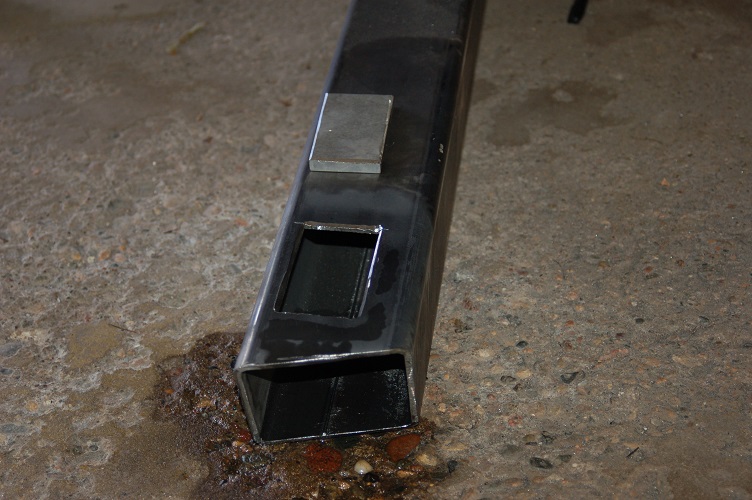 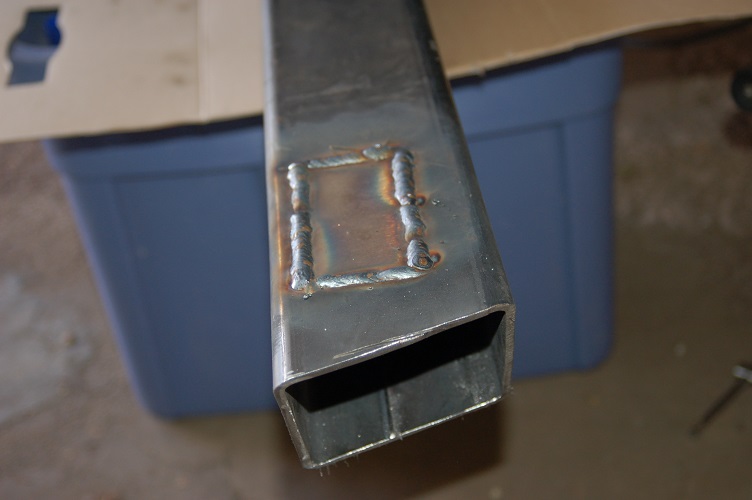 Then I trimmed the front end of the tube to angle it back as it goes from outside to inside. You can see that in the picture above. That was to keep the same clearance between the tire and the inside edge of the tube as there is between the tire and the outside edge as the tire swings through turns. And finally for the visible progress I cut a flat piece out of my extra 4x4 tube to cap off the front end and then welded it on. Again I'm happy with how the welds worked out (given who was doing the welding). In this picture the tube is upside down, so the corner closest is the inside corner that will be least visible. I started with that corner to try to figure out what I was doing before I welded the more visible corners. 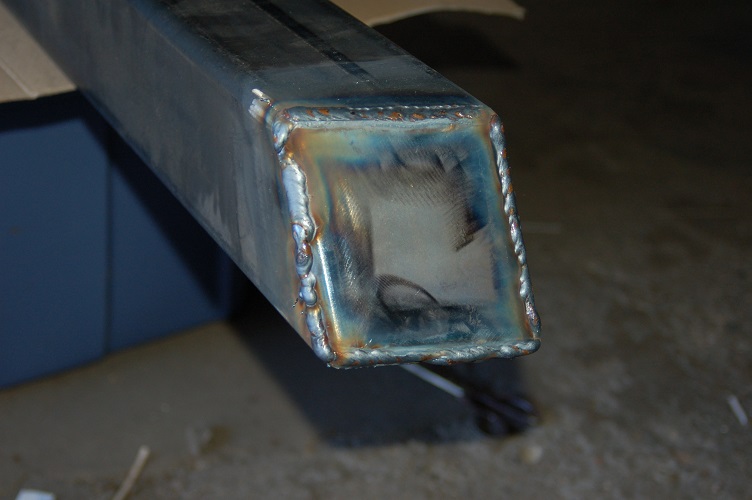 Then it was time for the other kind of progress. I took a flap wheel or wire wheel (whichever would fit) to the dirty, rusty surfaces that are going to get welded to the tube. This was slow, tedious progress, much of it working from my back on a creeper. But it cleaned up a lot better than I expected. There's a little cancer in the inner rocker just behind the "A" pillar, but otherwise the entire inner rocker cleaned up to solid metal. And even the door sill cleaned up a lot better than I expected. So not fun progress, and not obvious. But I'm getting a lot closer to being ready to weld the tube in! 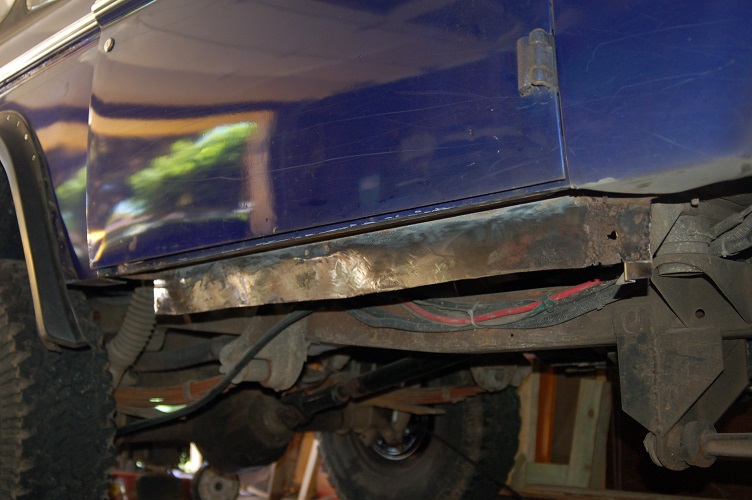 Looking again at the existing structure inboard of the inner rocker I'm more convinced that this will be strong enough without adding any additional supports or ties back to the floor or frame. At the back of the door there's an angled brace that goes up and in to a body mount and the reinforced floor there. In the middle of the door there's a hat channel that reinforces the floor, and the end supports the inner side of the inner rocker (these are both shown in the first picture below). And at the front of the door there's another angled brace that goes up to the reinforced floor at another body mount (second picture below). I'm not thinking that this will result in something that could never be damaged. But for how this Bronco is used I think it will work out fine. 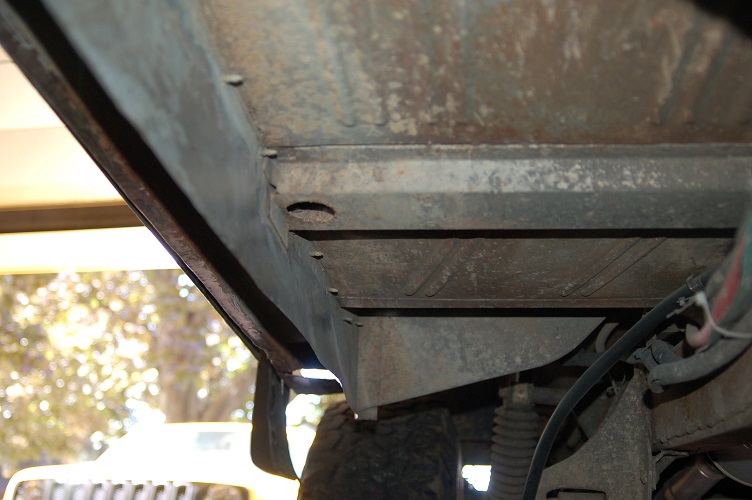 
Bob
Sorry, no '80 - '86 Ford trucks "Oswald": 1997 F-250HD crew cab short box, 460, E4OD, 4.10 gears "Pluto": 1971 Bronco, 302, NV3550 5 speed, Atlas 4.3:1 transfer case, 33" tires "the motorhome": 2015 E-450-based 28' class C motorhome, 6.8L V-10 "the Dodge": 2007 Dodge 2500, 6.7L Cummins |
|
Administrator
|
That's really good progress, Bob! And those welds are excellent. I wish mine were that good.
On the strength issue, I agree with you, it'll be strong enough - assuming that the way you put the piece on top of the 4x4 prevents the 4x4 from rotating. Let me say that another way. As long as all of the forces are in the vertical plane then it is strong. But imagine if the piece on top was just a thin piece and you placed it on the top inside edge of the 4x4 and started lifting the vehicle by pressing on the bottom outside edge of the 4x4. The 4x4 would want to rotate and it would bend the rocker out at the bottom. So you need the piece on top to be wide enough to reduce the rotational forces on the 4x4 enough so the inner rocker won't bend. Does that make sense? I don't think I explained it very well.
Gary, AKA "Gary fellow": Profile
Dad's: '81 F150 Ranger XLT 4x4: Down for restomod: Full-roller "stroked 351M" w/Trick Flow heads & intake, EEC-V SEFI/E4OD/3.50 gears w/Kevlar clutches
|
Re: Nothing Special's '71 Bronco
|
This post was updated on .
Yep, that makes sense. And I think I'll be fine there as well.
The 4x4 will have the 3/4 x 1 spacer on top that will be welded to the door sill. At both ends the door sill curves up into the "A" and "B" pillars. So that will help keep the rocker from rotating. The angle brace at the front body mount (bottom picture in post above) comes down below what I left of the inner rocker. I'm planning on welding that to the 4x4 as well. So that will also help prevent it rotating. The angle brace at the rear of the door (second-to-last picture above) is solidly connected to the inner rocker (which is solid at that point). So the spot welds between the inner rocker and the 4x4 will let that brace also help in tension which will help prevent rotation. Again, I'm not thinking this is "bomb proof". It wouldn't be what I'd do if this was a rock-bouncer tube buggy. But it should be really good for what the vehicle is and does. edit to add: Oh, and thanks for the compliments! I've never done enough weld to actually feel good at it, but I have access to a pretty good machine at work, so I've been able to at least feel competent. I've been wanting to get my own welder for a while now, and since I can't get a vehicle to the welder at work (or take the welder out to a vehicle) I needed my own for this project. I've heard enough people say (I was never a good welder until I bought a good welder", so I got a Millermatic 215. So far I'm happy with it!
Bob
Sorry, no '80 - '86 Ford trucks "Oswald": 1997 F-250HD crew cab short box, 460, E4OD, 4.10 gears "Pluto": 1971 Bronco, 302, NV3550 5 speed, Atlas 4.3:1 transfer case, 33" tires "the motorhome": 2015 E-450-based 28' class C motorhome, 6.8L V-10 "the Dodge": 2007 Dodge 2500, 6.7L Cummins |
|
Administrator
|
Your welds are looking good.
 I think the issue may be when it comes to attaching the box to sheet metal. The proverbial "welding a razor blade to a boat anchor" Very hard to have enough heat in a big chunk of steel (because it is conducting it away) for good penetration, without instantly vaporizing the sheet metal. Bonding is an option, as Gary mentioned. I'd grind up the surface of the box and run a fat bead in the center of your area. You've put enough when you see it squeeze out all around. The other advantage is that there are no voids for water (or even air) to start corrosion. I didn't see it mentioned, but have you thought of Cosmoline in the tubes? I've seen WW-II surplus that still has that stuff intact!
Jim,
Lil'Red is a '87 F250 HD, 4.10's, 1356 4x4, Zf-5, 3G, PMGR, Saginaw PS, desmogged with a Holley 80508 and Performer intake. Too much other stuff to mention. |
|
In reply to this post by Nothing Special
I have pictures saved somewhere of a project similar to this on a bit newer bronco. I have always kept the thought of cutting out the rust in the floor edge/rocker and replacing it with a wider profiled tube all the way up to the lip where the doors weather stripping lives (2x6 maybe) then tie some kickers over to the frame. Basically removing the bottom outside edges of the body 5-6 inches and flush the tube up into the body. And weld a small angle on top of the tube for the weatherstrip to go on. The doors would have to be modified to match on my body style. You gain some height on the rockers that way too. A person can even incorporate a slick material into panels underneath in the openings like skid plates but thick light weight plastics. The stuff that slides on obstacles without being destroyed and isn't super heavy. I have seen people fill tubes and even rocker panels in small unibody cars with some of that hard expanding foam. I think there are mixed results with the method, but allegedly you can stiffen the structure, and keep junk from going into the space. You have to carefully choose what foam you fill with, and when you install it... (After welding is all complete) I do think with the right product you could get something that could stick to the steel internally not degrade as it will be protected from the sun, but personally I would probably just weld them shut. You can always weld onto them, and cut out to repair.
I like the way your project is progressing quite a bit. I will be following along now. Maybe I will try and find those pictures back, I can't even remember who's project that was now. My bronco body is rough enough there is no reason for me to try and restore it. I have considered a bobbed stepside bed/flatbed and a regular cab swapped on, but the more I read about what you are doing the more I like this option... Perhaps my bronco will remain a bronco yet (with some enhancements, make it better with what's available to work with). Keep going, I approve not that it matters. EDIT THIS is what I was thinking of. Not sure it will be of any use, but more information is usually a helpful thing.
1985 Bronco
6.9 IDI hydroboost brakes 8 Lug coil sprung D44ttb 10.25 3:55 warn classic bumper 8274 warn winch Saginaw Conversion 1986 Ford F350 "Dump Truck" 6.9 IDI T19 8'x12'x4' hydraulic dump bed front mounted tow bar 1981 Ford F350 "Welding Truck" 300 I6 T18 Welders bed with hoist onboard air |
Re: Nothing Special's '71 Bronco
|
In reply to this post by ArdWrknTrk
Thanks! I still think I'm going with welding. One of the things I'm going to be working on in the next couple of days is prepping some of the rusty junk I cut off for welding so I can practice welding that to some scrap pieces from the tube. If I can't get that to work adhesive may well be the plan B. I've never seen Cosmoline in real life (and wouldn't know where to get it). But my impression is that it's more of a wax or at least grease consistency, and I don't see a way to apply that to the inside of a 54" long 4x4 tube, even if the ends hadn't been welded shut yet. Am I wrong? Does it go on as a liquid? So far your suggestion of bar oil seems like the best bet (although I don't see mixing it with wax as you suggested for the same reason as the Cosmoline).
Bob
Sorry, no '80 - '86 Ford trucks "Oswald": 1997 F-250HD crew cab short box, 460, E4OD, 4.10 gears "Pluto": 1971 Bronco, 302, NV3550 5 speed, Atlas 4.3:1 transfer case, 33" tires "the motorhome": 2015 E-450-based 28' class C motorhome, 6.8L V-10 "the Dodge": 2007 Dodge 2500, 6.7L Cummins |
Re: Nothing Special's '71 Bronco
|
In reply to this post by IDIBronco
Thanks for the kind words!
I looked at the project you linked. That looks great, but beyond what I want to do or what I think I need to do. Not saying it isn't a good choice for you, but when I read "modified the doors" I knew I was out! And as I've noted, tying to the frame on the driver's side isn't really possible due to the aux gas tank. Of course that doesn't mean that I couldn't on the passenger side, but it doesn't seem necessary to me for this vehicle. Again, not that it's a bad idea, just probably not for me in this case. Filling with foam doesn't seem necessary or advisable to me. Sort of like Ford pickup cab corners. Filling metal with something that holds moisture in once it's there doesn't seem like a good way to prevent rust, even if it makes it harder for the moisture to get there in the first place. My original thought was to spray so WD-40 ("Water Displacing") in, but Gary and Jim's concerns about that evaporating out pretty soon, and Jim's suggestions of more stable stuff have me leaning toward bar oil now. By the way, I don't think I've mentioned it yet, but my plan for mounting the rub rails includes running stand-offs all the way through the 4x4 tube so they will be welded to both the inner and outer walls of the 4x4. That won't do much to strengthen the tube against a hit on the bottom, but it will strengthen it against hits from the side. I do, in general, like the idea of the HMWP (? maybe I have the initials wrong, but the cutting board plastic that people use on skid plates). But I don't think it will be a big issue on these rockers. In the picture below (posted several days ago) you can see how far down the radius arm mounts are below the rockers. That's what hits the rocks the hardest! And in between the radius arm mounts the transfer case hangs almost that low. The hope for next winter's project (once I finish this up which was supposed to be LAST winter's project!) is a tummy tuck to get all of that higher and get a skid plate under it. I MIGHT put plastic on that skid plate. But I don't think it'll be as needed here. 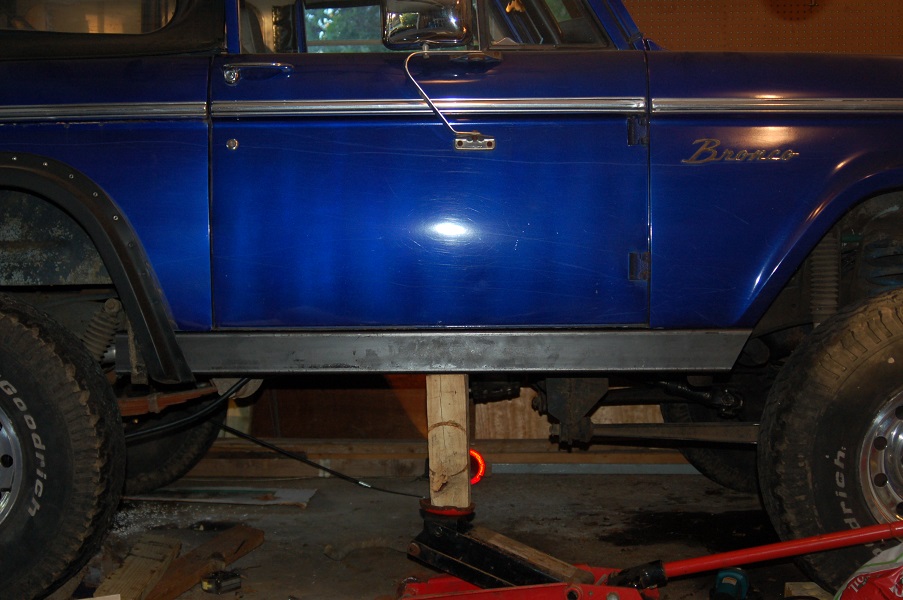
Bob
Sorry, no '80 - '86 Ford trucks "Oswald": 1997 F-250HD crew cab short box, 460, E4OD, 4.10 gears "Pluto": 1971 Bronco, 302, NV3550 5 speed, Atlas 4.3:1 transfer case, 33" tires "the motorhome": 2015 E-450-based 28' class C motorhome, 6.8L V-10 "the Dodge": 2007 Dodge 2500, 6.7L Cummins |
Re: Nothing Special's '71 Bronco
|
OK Gary and Jim, you have me thinking about panel adhesive now, I've never used that stuff before. Help me think through what that process would look like.
Sorry for all the questions, but my lack of familiarity with the process gives me some concerns about whether I can do it well, which is why I'd rather go with welding. That's a process I'm familiar with and I know that I'll have all the time I need to do it right. But as Jim brought up, adhesive would do a much better job of preventing rust from starting between the pieces. So I would like to understand how challenging it might be to glue it in. As I understand, panel adhesive is supposed to be applied to bare metal. I'm thinking with the rusty metal I'm starting with I'd still want to coat it with Ospho, but maybe after the Ospho has had its time to work I'd sand it down again? And how long do you have after applying it before it better be assembled and clamped? I'm thinking that it could easily take me around a half hour to get it all spread on and get the tube lifted up into position. And then more time to get it clamped down well. And clamping it. No trouble holding it up against the door sill. I can use a jack for that. But what about the inner rocker? As I understand you should use a lot of clamps to get good, even pressure on the sheetmetal (I think a single jack against the bottom of the tube will still put even pressure against the door sill). But I don't really want to buy a dozen 6" C-clamps to clamp the inner rocker to the tube (not that 12 would even be enough...). What about using 2 or 3 6" C-clamps to clamp a piece of say 1" square tubing to the inside of the rocker, sandwiching the inner rocker sheetmetal between the 1x1 and the 4x4? Would that be good enough? Or would I need to do 2 of those, one along the top of the inner rocker, one nearer the bottom? And if I get it lifted into position (before clamping it) how much leeway do I have to move it around to get it positioned correctly? I know that as I've been test fitting it I rarely get it in the right position the first time. I at least need to tap it forward or backward to get it lined up, and then tap it inward to get it tight against the inner rocker (although the clamps will help with that). But with the adhesive on it will I have time to move it around like that or will it really try to stay where it first touches? To maybe help picture everything a little, here's my crayon sketch of a cross section of the rocker. The blue is original metal that I'm keeping, the red is original metal that's gone (either due to rust or due to a cutoff wheel) and the black is the metal I'm adding. If I weld I'm thinking of spot welds between the inner rocker and the 4x4, spot welds between the door sill and the 3/4 x 1 spacer, and a weld bead along the outer edge of the door sill outer step and the 4x4 (to keep that from being a sharp edge that cuts peoples calves as they get in and out). If I glue it I imagine using adhesive between the inner rocker and 4x4, between the door sill and the spacer, and also between the door sill outer step and the 4x4 (I'd probably try to feather that edge in with a flap wheel after the adhesive had cured). And probably using another 1x1 to clamp the outer door sill down to the 4x4. 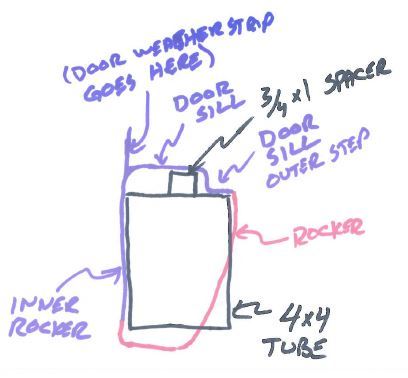
Bob
Sorry, no '80 - '86 Ford trucks "Oswald": 1997 F-250HD crew cab short box, 460, E4OD, 4.10 gears "Pluto": 1971 Bronco, 302, NV3550 5 speed, Atlas 4.3:1 transfer case, 33" tires "the motorhome": 2015 E-450-based 28' class C motorhome, 6.8L V-10 "the Dodge": 2007 Dodge 2500, 6.7L Cummins |
|
Administrator
|
I don't think it'll take you that long to get things in position, but 3M's Panel Boding Adhesive has a handling time of 90 minutes and a curing time of 24 hours.
And I don't think you'll need more than maybe 3 C-clamps with the piece of 1" to spread the load. You don't want to squeeze all of the adhesive out. But I used it on painted surfaces. So I don't think you have to get the treatment off.
Gary, AKA "Gary fellow": Profile
Dad's: '81 F150 Ranger XLT 4x4: Down for restomod: Full-roller "stroked 351M" w/Trick Flow heads & intake, EEC-V SEFI/E4OD/3.50 gears w/Kevlar clutches
|
|
Administrator
|
In reply to this post by Nothing Special
Ultra High Molecular Weight Polyethylene (UHMW) is used a lot as an inexpensive alternative to Delrin (acetal) and Teflon (polytetrafluorethelyne) PTFE.
I've used it for things as diverse at rail buttons for my rockets to lining a slice gate channel in a dam. It would work great for a rub rail, just be sure to sink the fasteners well below the surface. Panel adhesives have all different cure times, and you have further control by raising or lowering the ambient temperature. Letting some dry ice cool the rails before clamping would slow the cure in summer. Putting them on a heater would speed it in winter. If treating with Ospho (I use KleanStrip Concrete and Metal Prep from the big box) I would just rinse with water, or a mild basic solution to make sure the acid is gone. Panel adhesive is just a toughened epoxy, but I wouldn't apply it over paint like Gary. In that case the paint's adhesion is the weak link. (Paint is NOT an adhesive) Composite/materials nurd since I first played in mud...... 
Jim,
Lil'Red is a '87 F250 HD, 4.10's, 1356 4x4, Zf-5, 3G, PMGR, Saginaw PS, desmogged with a Holley 80508 and Performer intake. Too much other stuff to mention. |
|
Administrator
|
I agree that you wouldn't want to paint your parts and then use the panel adhesive. I was just saying it will stick to paint.
Gary, AKA "Gary fellow": Profile
Dad's: '81 F150 Ranger XLT 4x4: Down for restomod: Full-roller "stroked 351M" w/Trick Flow heads & intake, EEC-V SEFI/E4OD/3.50 gears w/Kevlar clutches
|
|
Administrator
|
It's a glue. It'll stick to just about anything (including your clothes and yourself!
 ) )
Jim,
Lil'Red is a '87 F250 HD, 4.10's, 1356 4x4, Zf-5, 3G, PMGR, Saginaw PS, desmogged with a Holley 80508 and Performer intake. Too much other stuff to mention. |
Re: Nothing Special's '71 Bronco
|
One more question about panel adhesive. How good is it in constant tension? It turns out that the inner rocker is a bit too long.when I get the 4x4 into position the inner rocker is bowed in, leaving a big gap between it and the 4x4. I can C-clamp a 1x1 against the back side of it and pull it tight against the 4x4, so I could hold them tight together while the adhesive cured. But the sheetmetal really wants to pull back away from the 4x4. Will the adhesive hold it there against a constant stress?
Bob
Sorry, no '80 - '86 Ford trucks "Oswald": 1997 F-250HD crew cab short box, 460, E4OD, 4.10 gears "Pluto": 1971 Bronco, 302, NV3550 5 speed, Atlas 4.3:1 transfer case, 33" tires "the motorhome": 2015 E-450-based 28' class C motorhome, 6.8L V-10 "the Dodge": 2007 Dodge 2500, 6.7L Cummins |
|
Administrator
|
Tensile strength is more than adequate.
I can try to find that data. I'd only be concerned about peel, but on sheet metal to sheet metal joints I've seen the epoxy hold and the metal tear. This stuff is authorized by the DOT and the insurance companies. Good body shops use it in some situations because it doesn't distort or affect the temper of panels. I think Gary's body guy (John?) Was going to use it for attaching new bed sides.
Jim,
Lil'Red is a '87 F250 HD, 4.10's, 1356 4x4, Zf-5, 3G, PMGR, Saginaw PS, desmogged with a Holley 80508 and Performer intake. Too much other stuff to mention. |
|
Administrator
|
In reply to this post by Nothing Special
I think it will hold that easily. But I don't have any data to back that up. Perhaps on the pages I linked to below there is info on that?
However, you could drill and tap the 4x4 to suck the inner rocker down against it. Or, do as I did, and use big pop rivets to pull them together. I used Marson 3/16" stainless rivets with a grip range of .062 to .270" to do that. And by having the adhesive already in between the parts I knew that the holes would be sealed. The adhesive I used was SEM DUAL-MIX™ MULTI-PURPOSE PANEL ADHESIVE Part #39747. But SEM also makes DUAL-MIX™ STRUCTURAL IMPACT RESISTANT ADHESIVE Part #39757 which might be a better fit. However, they both require use of a special gun, and you'll need to borrow one of those or buy it, and I think they may be expensive.
Gary, AKA "Gary fellow": Profile
Dad's: '81 F150 Ranger XLT 4x4: Down for restomod: Full-roller "stroked 351M" w/Trick Flow heads & intake, EEC-V SEFI/E4OD/3.50 gears w/Kevlar clutches
|
Re: Nothing Special's '71 Bronco
|
In reply to this post by ArdWrknTrk
Good to know that the tensile strength is really good, but throwing a few screws in there seems like a good idea too. I think I'd drill and tap it after the adhesive cured but before I removed the clamps. It's only 3/16" wall, but that's about right for a #10-32. Or maybe I should use pop rivets. That would be easier and quicker that tapping anyway.
FWIW, I'd be a lot less concerned about mounting bed sides with the stuff than having something trying to pull it apart with probably over 100 lbs of force. But it is a lot of area, so perhaps the stress (force per unit area) isn't that high anyway.
Bob
Sorry, no '80 - '86 Ford trucks "Oswald": 1997 F-250HD crew cab short box, 460, E4OD, 4.10 gears "Pluto": 1971 Bronco, 302, NV3550 5 speed, Atlas 4.3:1 transfer case, 33" tires "the motorhome": 2015 E-450-based 28' class C motorhome, 6.8L V-10 "the Dodge": 2007 Dodge 2500, 6.7L Cummins |
|
Administrator
|
If you intend to add fasteners after cure, at the very least dab some epoxy on the things and in the hole before you tighten it up.
But you have a lot of area, and if you get 100% fill (as shown by squeeze out when you lay a central bead) I think there's really nothing to worry about. 4x50 is 200 sq."
Jim,
Lil'Red is a '87 F250 HD, 4.10's, 1356 4x4, Zf-5, 3G, PMGR, Saginaw PS, desmogged with a Holley 80508 and Performer intake. Too much other stuff to mention. |
| Edit this page |

